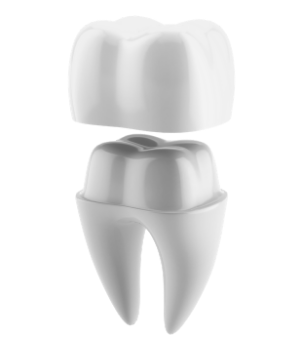Crown and Bridges
Both Dental Crowns and Bridges are cemented on existing tooth and are used to replace and rebuild tooth. Crowns and Bridges can strength your oral function / health and provide a great aesthetic transformation.
What is a Dental Crown?
A Dental Crown is a customised “cap” that fits over an existing tooth, replicating appropriate teeth form and function. Historically, they were often made of gold and other metal alloys but advances in technology nowadays means Crowns can be made of porcelain or ceramic that not only provides good strength but can beautifully mimic teeth colour and appearance.

What is a Dental Bridge?
Bridges are essentially a connection of Dental Crowns and are often used to replace one or more missing teeth. The Crowns are placed on top of adjacent teeth to “bridge” the gap of the missing area to improve appearance and function. This is important as gaps left by missing teeth can cause other teeth to shift and rotate, in the long term this can lead to a poor bite and the smile can become unsightly.
Unlike removable appliances such as Dentures which you can remove from your mouth for daily cleaning and place back when in use, Dental Crowns and Bridges are permanently fixed onto existing teeth or Dental Implants. They held onto existing teeth with a sturdy dental glue, allowing them to fit perfectly into the mouth so that you can feel natural and comfortable when you eat and speak.
Why is a Dental Crown or Bridge needed?
The main reason a Dental Crown or Bridge is recommended is to strengthen and protect a damaged tooth so that it does not lead to catastrophic failure requiring tooth extractions. Crown and Bridges are also a very popular Cosmetic Dentistry procedure as they are not only comfortable but highly effective in changing the aesthetics of your teeth, transforming your smile.
Examples of instances where Dental Crowns are advised:
- Protect tooth from further cracks
- Rebuilding a broken tooth where there is minimal tooth structure
- Restoring a severely decayed tooth where normal fillings cannot provide enough strength for regular chewing
- Strengthening a weakened root canal tooth
- Reinforcing a weakened filling
- Cover the top portion of a implant that sits above the gum line
- Improve the appearance of a discoloured or poorly shaped tooth
- Improve teeth alignment
Examples of instances where Dental Bridges are needed:
- To replace a single missing tooth or multiple missing teeth
- Where wearing dentures cannot be tolerated
- Strengthening neighbouring teeth that are weakened from decay or cracks
- To improve the alignment of oddly shaped teeth
- To improve the uniformity and colour of discoloured teeth
- To connect two implants together
How long do Dental Crowns and Bridges last?
Research has shown evidence that Dental Crowns and Bridges can last upwards 10 years, sometimes even 20 to 30 years.
Since the Crowns and Bridges are fixed onto natural teeth, if there are any dental diseases to the teeth or the bone that supports it, for example dental decay and Gum Diseases, this can compromise how long the Crowns and Bridges will last.
It is important to keep the area clean and practice good dental health to keep diseases at bay. This involves brushing the teeth with a fluoridated toothpaste twice, flossing or cleaning between the teeth once a day and seeing Dentists regularly for Professional Check ups and Cleans.
Dental Crowns and Bridges Treatment Process
1. Book a consultation
Make a booking online or call us on 03 9748 7271 to set up a consultation date. We'll go through your available options and advise you of the best course of treatment and answer any questions you may have.
After it has been decided that Dental Crowns or Bridges is the best option for you, the process requires two visits.
Visit 1:
2. Photos
Photographs may be taken of your smile and teeth, these images are often sent to the laboratory technician to help them with the process of making and shaping the Crowns/Bridges so that they can look as beautiful as possible. We also like to show you some before and after shots of your smile transformation.
3. Preparation
After getting you comfortable, we may reshape and resize your tooth/teeth so that there is enough space for the future Dental Crown or Bridge to fit over, this ensures appropriate strength and appearance required of the Crown or Bridge.
4. Creating your moulds
A mould is taken of the area, this will be sent to specialist technicians to build and create the artistic component of the Crown/Bridge such as the angles, lines, curves, and colour tints.
5. Colour matching
We'll spend some time with you to help match the colour of your new Crown/Bridge to your existing teeth. Our Dentists will also consider the most appropriate materials to use for the Crown/Bridge.
6. Temporary Crown
We'll send you home with a temporary plastic Crown in place over your tooth to help protect it until your second visit.
Visit two:
7. Checking your new Dental Crown or Bridge
During your second visit, we'll check the fit of your new Crown/Bridge, making sure you feel comfortable in the way you talk, chew and bite. If there are any discomfort, we will adjust appropriately. If any resizing is required we may send the Crown / Bridge back back to the technician for adjustment to be certain that you get the best solution possible.
8. Fixing your Crown/Bridge
Once you and the Dentist are happy with the results, the Crown/Bridge is fixed into place by a cement.
9. Enjoy!
That concludes the treatment process. You can then go about your normal day with a beautiful and functional looking tooth or set of teeth!


